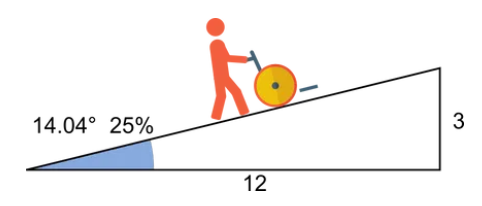 Home
Home
 Back
Back


Definition: This calculator determines the slope angle, elevation grade, run, and ramp length for a ramp with a fixed 3:12 slope ratio, designed for loading and unloading unoccupied wheelchairs.
Purpose: It assists in designing ramps for temporary or specific use cases, such as vehicle loading ramps or storage, where the wheelchair is unoccupied and a steeper slope is acceptable.
The calculator uses the following equations for a 3:12 slope ratio (3 units rise per 12 units run, equivalent to 1:4):
Where:
Steps:
Calculating the correct ramp dimensions for a 3:12 slope is critical for:
Example: Calculate the ramp parameters for an unoccupied wheelchair slope:
Q: What does the 3:12 slope ratio mean?
A: A 3:12 ratio means 3 units of rise per 12 units of run (or 1:4), resulting in a slope of approximately 14° or 25%, suitable for loading and unloading unoccupied wheelchairs.
Q: Is the 3:12 slope safe for occupied wheelchairs?
A: No, 3:12 is too steep for occupied wheelchairs and does not meet ADA standards. It is designed for unoccupied wheelchairs during loading or unloading.
Q: Does the calculator account for ramp landings?
A: No, it calculates the straight ramp segment. Landings are typically not required for short, temporary ramps used for unoccupied wheelchairs.